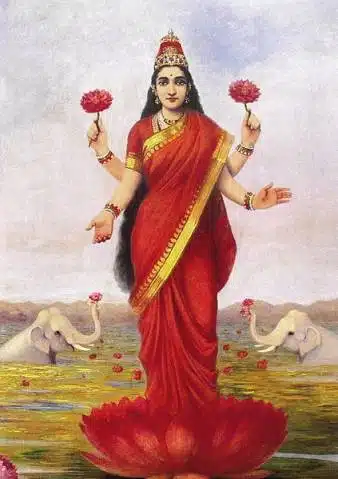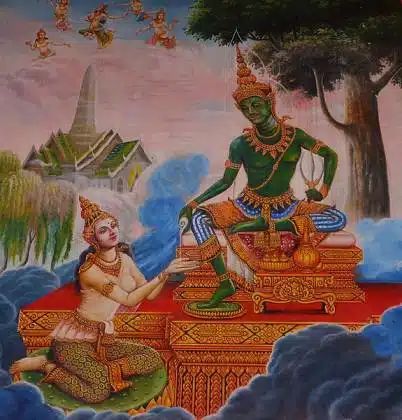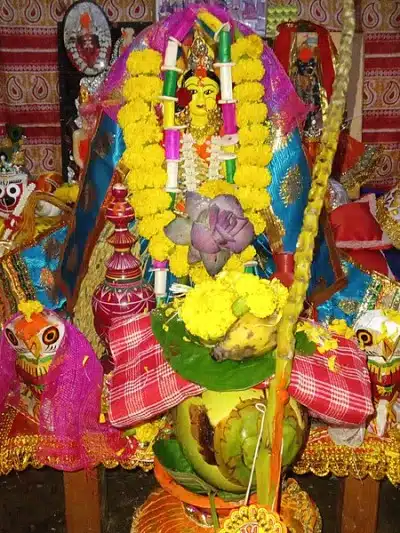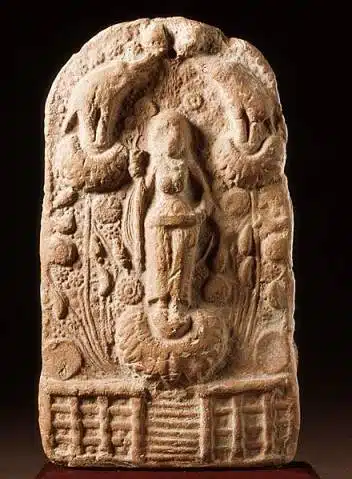Goddess Lakshmi or Devi Lakshmi is one of the principal deities of Hinduism. She is known as the Goddess of wealth, fortune, prosperity, bliss and auspiciousness. It is important to remember that Devi Lakshmi embodies not just the values of material prosperity and wealth but also spiritual prosperity.
The Sanskrit word Lakshya which translates into “aim” in English is also derived from the word Lakshmi. In Hindu philosophy, the aim of this life is to attain both material prosperity and spiritual enlightenment. Goddess Lakshmi paves the way for both and blesses devotees who worship her with utmost devotion and purity and lead a righteous and ethical life following Dharma(ethical rules).
Goddess Lakshmi is usually depicted draped in a bright red sari, an epitome of beauty adorned in precious gold ornaments seated on a lotus. She is often shown with four arms, symbolic of the four goals of humanity. These goals are considered good in Hinduism: Dharma (pursuit of moral life), Artha (pursuit of wealth), Kama (pursuit of love), and Moksha (pursuit of liberation). Devi Lakshmi’s four hands are also said to symbolize the four Veda (sacred texts) of Hinduism.
Each of Goddess Lakshmi’s upper hand is depicted as holding a lotus and a white elephant stands on each side. Devi Lakshmi has many other names like Kamalā, Ambujā, Padmā, etc that are synonyms of lotus. The lotus flower thus has special significance in Devi Lakshmi’s iconography. It is a symbol of beauty, purity, and fertility. The elephants in the background symbolize hard work and power.
Grantor of Wealth and Prosperity
Hinduism is perhaps the only religion in the world with such an elaborate tradition of Goddess worship. The feminine divine is worshipped in Hinduism.

Hindu Goddesses are often as powerful and influential as the Gods. Each Goddess embodies a particular set of qualities in the great pantheon of Hindu goddesses.
Goddess or Devi Lakshmi is the Goddess of Prosperity( both material and spiritual) and wealth.
She is also the embodiment of grace, charm, and beauty. In Hinduism, Goddess Lakshmi epitomizes wisdom, fortune, generosity, courage, light, and fertility. She is known to be the daughter of mother Goddess Durga and the wife of lord Vishnu who is the preserver of the universe in Hindu mythology.
Goddess Lakshmi – Symbol of Auspiciousness
No auspicious occasion is complete without the worship of Devi Lakshmi. She is often worshipped alongside lord Ganesha, an equally auspicious deity in Hinduism.
Devi Lakshmi is such a vital part of Hindu culture and identity that many Hindus, especially in the olden days, chose to name their daughter Lakshmi. It is believed that by naming their daughter Lakshmi, they are paving the way for good fortune and permanent bliss to enter their homes.
Devi Lakshmi is also associated with the Amla(citrus) tree. It is believed that the Hindu Goddess of Prosperity resides in the leaves of this tree. Thus, the leaves of this tree are worshipped to seek the blessings of Goddess Lakshmi, especially during the months of November and December.
Devi Lakshmi is imbued with Sattvic qualities and she is an embodiment of the bountiful and beautiful aspect of nature. Lakshmi stands for all this positive, blissful, and life-affirming; she protects her devotees from all material and spiritual sorrows and suffering.
Goddess Lakshmi Origin: the Perfect Creation
The origin of Goddess Lakshmi is described in one of the central Hindu legends. According to the story, Sage Durvasa offers a garland of flowers to Lord Indra with a lot of respect. Lord Indra takes the flowers and places them on the forehead of his elephant. The elephant throws it down to earth. Sage Durvasa gets angry at this blatant display of disrespect and curses Lord Indra. He curses Indra, saying his kingdom would be destroyed, just like the garland he had thrown.
As Lord Indra returns to his capital Amravati, he sees that Gods and people have lost their vigor and energy, and all vegetables and plants have started dying. Everyone’s desires have become uncontrollable. The demons invade the weak gods. This symbolizes the archetypal battle between good and evil that resides within all of us.
After this, the Gods approach Lord Vishnu, who suggests the churning of the ocean to restore their power. The churning would provide Amrit (nectar) to the gods which would make them immortal.
Goddess Lakshmi Rose out of the ocean foam
And, thus according to the legend, Goddess Lakshmi emerges, among other precious things, from the foam of the ocean of milk. She rises out of the waves, seated on a full-blown lotus. When she first appeared, she had the option of going to the Devas or the Asuras. She chose the Devas’ side, and among the thirty deities, she chose to be with Vishnu.
Interestingly, this creation story shares many similarities with the creation myth of the Greek goddess Aphrodite. She to (at least in one version) was said to come out of sea foam.
Another legend about her birth is that she was born from Prajapati’s mouth. She was born to provide the inhabitants of the cosmos with food, clothing, shelter, and all things that make life more comfortable. But other Gods, dazzled by her beauty and power, immediately wanted to murder her and appropriate all her gifts. But they were stopped by Prajapati, who told them to take what they wanted, but without violence.
Family and Incarnations
Lakshmi is both the consort and the divine energy of the Hindu God Vishnu. Vishnu is the God responsible for preserving and protecting creation. He is the embodiment of goodness and mercy, as well as the self-existent and powerful power that keeps the cosmic order in place. He is the deity of Shanti (peaceful mind), he never sleeps and cannot stand ego.
Lakshmi assists Vishnu in his role to create, protect, and transform the universe. Also, she plays a special role as the mediator between her husband, Vishnu, and his worldly devotees. She is considered inseparable from Vishnu and takes different forms to be with him in his different births. These incarnations were intended to either prevent a great evil or bring about good on Earth.
Various Avatars of Goddess Lakshmi
In one of her incarnations, she was Sita. Vishnu was born and became famous as Shri Rama, her husband. They are the central figures of the ancient Hindu epic “Ramayana.” In this form, Lord Rama is a fearless upholder of the law of Dharma. And Sita helps and supports her husband in his roles as a son and brother.
She even went with him to his exile, and during this period, she was abducted by the King of Lanka Ravana. Lord Rama killed Ravana and saved Sita. This symbolizes the victory of good over evil and Dharma over Adharma.
In another birth, she assumed the form of Rukmini, the wife of the Hindu God Krishna.
According to the story, Rukmini’s brother wanted to marry her to one of his friends but she was in love with Krishna. Thus, she dispatched a Brahman to request that Krishna elope with her on her Swayamvara. The Brahman described the princess poetically as bearing beautiful hands, braided hair, and a face that resembled the moon. Krishna accepted her request and soon swept her into his chariot with him. Rukmini’s brother and other allies chased them and challenged Krishna. But, at Rukmini’s request, Krishna agreed to spare her brother’s life in exchange for shaving his hair and mustache as a punishment. After this, they were married with great pomp and ceremony.
Ashtalakshmi form of Goddess Lakshmi
In Hindu mythology, one of her forms, Mahalakshmi, placed the seed of divine desire in the palm of her hand. And she unleashed the dynamic forces of creation until the three worlds took shape and all forms of life came forth.
In her form as Ashtalakshmi (the eight manifestations of Lakshmi), she presides over eight sources of wealth. These include spirituality, material wealth, agriculture, royalty, knowledge, courage, progeny, and victory.
Goddess Lakshmi’s role and responsibilities
Over everything else, Goddess Lakshmi is seen as independent. Her association with many Gods in myths and even with asuras gave her the image of being restless and independent. This is indicative of the restlessness and maybe fleeting nature of fortune and wealth.

Though Lakshmi’s forms are distinct, her encompassing nature is that of a nurturing and protective mother. She gives devotees what they need while at the same time encouraging them to work hard and persevere.
She is the storehouse of all the universe’s wealth, helping to fulfill the potential of those who resolve to conquer the mind despite all difficulties. One of her forms, Dhanya Lakshmi, highlights the importance of showing gratitude for Mother Nature’s miracles.
Also fulfilling the desire for vibrant and long-living offspring, she blesses those who honor parenthood as a sacred duty.
She grants one the fearlessness needed to go through life’s ups and downs. Thus she favors those who resolve to remain determined and optimistic in all circumstances. She brings knowledge to provide divine wisdom to spiritually transform people’s lives.
Myths and legends
Hindu culture and civilization are known for oral storytelling, These popular stories about Hindu Gods and Goddesses get passed down from generation to generation.
The original source of some of these stories is the Hindu sacred texts such as Puranas, whereas it’s difficult to identify the source for other stories. But that’s precisely the beauty and dynamism of Hindu culture. The same Goddess or Devi is worshipped in many ways across different traditions in India. Every region of India has its own local folklore associated with the Gods and Goddesses of that region.
There are many stories, myths, and legends associated with Goddess Lakshmi as well. She sometimes plays the role of a protagonist, and other times she just plays an important part in the story. These stories are told by devotees on special occasions and at other times while reciting mantras to invoke and honor the goddess.
Jagannath Puri Myth of Mahalakshmi
According to one story, Mahalakshmi once became irritated with her husband. She went to live with the royal family of King Akasha in southern India. There now, calling herself Padmavati, she was eventually found by distraught Vishnu.
He was in disguise as Shrinivas. Brahma and Shiva conspired to have them meet. They fell in love with each other. and got married in a lavish ceremony. The day is still commemorated today in the town of Tirupati, in the Indian state of Orissa.
Shriya, a devotee of Lakshmi, once worshiped her, according to legend. She did the pooja (worship) following all the rituals meticulously. Moved by her devotion, Devi Lakshmi left her permanent abode, the temple of Jagannath, and visited Shriya’s house.
When Balaram, the elder brother of Jagannath, came to know about this, she was declared defiled and was not allowed to come back into the temple. In retaliation, the goddess Lakshmi walks off with her wealth and sets up another temple for herself.
Other stories surrounding Goddess Lakshmi
Lakshmi is often paired with Lord Ganesha, the God of Wisdom. Because Lakshmi was childless, she adopted him from Goddess Parvati. Mythology states that Lakshmi grew to care for him so much that she decided to share her power with him. The two are worshiped together in the sense that wealth and riches should be used wisely.
According to one legend, originally Lakshmi, Saraswati, and Ganga were the wives of Shri Hari in Baikuntha. Saraswati felt that Shri Hari was getting fonder of Ganga. She complained to Lakshmi, but Lakshmi was neutral. Saraswati was irritated and cursed Lakshmi to become a tree because she was insensitive.
Ganga felt bad and cursed Saraswati. This led Saraswati to curse Ganga. Reacting to this situation, Shri Hari gave dispensations, and accordingly, Lakshmi was to be born as a tree in the house of a king. She was to marry an Asura, a Vishnu devotee, and later become Shri Hari’s wife, and also as a river named Padmavati in Bharatvarsha (India).
Devotion to Goddess Lakshmi

Her statues and pictures, where she is often draped in a red sari and bedecked with gold ornaments, seated on a lotus, and flanked by white elephants, adorn Hindu homes and business establishments.
Lotus flowers, sandalwood, betel leaves, fruits, various sweets, rice, and coconuts are used for her ritual worship.
The festival of Diwali is celebrated in her honor. People clean their houses before Diwali. It is said that Goddess Lakshmi goes to only those houses that are clean, decorated, and have a festive look. On this day, Lakshmi puja, for invoking the goddess, is usually followed by Lakshmi Aarti.
According to beliefs held by Hindus, when she is pleased with the purity and devotion of her worshippers, she bestows upon them both material and spiritual prosperity. She also has a special place in the Buddhist and Jain religions.
In Buddhism, she is believed to be the peaceful form of Shri Devi Dudsolma the principal female protector. For Jains, she is the Devi of Artha and Kama. In the ancient scriptures of India, all women are declared to be embodiments of Lakshmi.
The popularity of Lakshmi can be seen by the fact that her sacred name “Shri” is written atop every document. The word “Shri” is associated with the material side of existence. It is also spoken before the name of any revered individual.
Significance of Goddess Lakshmi in the Hindu Festival Diwali
The Hindu festival of Diwali, also known popularly as the “Festival of Lights” is celebrated on the day of “Amaavasya” ( no moon day ) during October or November.
According to the legend, Diwali is celebrated to mark the return of lord Rama, his wife Sita, and brother Laxman to Ayodhya after the completion of 14 years of exile in the forest, and after the defeat of Lanka king Ravana who had abducted Sita. It is said that the residents of Ayodhya lighted diyas ( earthen lamps) along the path to welcome back lord Rama and Devi Sita in Ayodhya. Another legend says that Diwali is celebrated on the occasion of the rebirth of Devi Lakshmi during the period of Samudra Manthan ( the churning of the cosmic ocean).
Devi Lakshmi is the principle deity worshipped during Diwali. She signifies light, hope, bliss, abundance, and prosperity, all the values that the Hindu festival of lights stands for. On the day of Diwali, the main ritual in most Hindu households is Lakshmi Ganesh poojan ( worship ceremony).
Goddess Lakshmi and Diwali Rituals
On this day, Devi Lakshmi is worshipped along with Lord Ganesha. The Pooja ceremony takes place at a set auspicious time in the evening. Earthen idols of Lakshmi and Ganesha are worshipped; offerings of flowers, milk, and sweets are made to the Goddess. It is also a ritual to worship silver coins on this day since Goddess Lakshmi is the Goddess of wealth.
Cleaning of one’s inhabited space is both a literal and symbolic gesture during Diwali. People begin to clean up their homes and office spaces days before Diwali. It is believed that Goddess Lakshmi likes to enter places that are spick and span and reverberate with positive energy.
Cleanliness in Hinduism is associated with positive and Sattvic vibrations. Thus, the cleansing that takes place during Diwali is both material and spiritual. As the house gets cleansed of negative energies, it’s also a period of a rigorous cleansing of the soul.
The lighting of earthen lamps during Diwali is an integral part of the invoking of Goddess Lakshmi. People light up all the pathways of their home with earthen lamps and candles. It is believed that Goddess Lakshmi will walk down this lighted path to bless the household on the auspicious night of Diwali,
Goddess Lakshmi symbolizes good luck
Two days before Diwali falls the auspicious occasion of Dhanteras. Dhan in Sanskrit means wealth. Thus, on this day, devotees buy gold, silver, precious gems, jewelry, and new utensils to invite Goddess Lakshmi into their homes on the night of Lakshmi.
Lakshmi is also the Goddess of auspiciousness. Thus, Diwali is considered an auspicious time to embark on new projects and ventures.
Many Hindus get their home renovation projects implemented specifically around Diwali. It’s also considered an auspicious time to make major purchases.
If you purchase a new car or a property, it is believed that Goddess Lakshmi will bless you with prosperity and good luck if you make the purchase during Diwali.
Representation and Symbols of Goddess Lakshmi
The Vedas describe her as having eighteen hands. She is also very often shown with elephants. These elephants symbolize work, activity, and strength. Also, they represent water, rain, and fertility for abundant prosperity.

She is pictured sitting on a lotus, which represents self-realization and reality. This is a flower that blooms in clean or dirty water, which signifies purity, regardless of good or bad circumstances. This symbolizes that good and prosperity can bloom even if the surroundings are filled with evil.
She rides an owl that represents vice, which must be overcome to be blessed by Lakshmi. In the case of Lakshmi, an owl that sleeps during the day is symbolic of the darkness of ignorance. Therefore, it symbolically seeks to open our eyes to the light of wisdom residing within us.
Animals
Owl: The owl is the bird that is almost always present with the Goddess. It is her mode of travel. Furtherrmore, it represents wit, intelligence, and wisdom. It is believed that the owl is auspicious for achieving success.
Garuda (Eagle): The divine couple Vishnu and Lakshmi are carried on the magnificent shoulders of Lord Garuda. He is an example of a divine life, unsurpassed in strength and martial power.
Elephant: According to Hindu mythology, Gajalakshmi (Lakshmi with elephants) is credited with restoring the wealth lost by the god Indra. In relation to the goddess Lakshmi, elephants signify animal wealth and other forms of wealth that represent strength.
Plants
Goddess sits on an open lotus and hence it is considered her favorite flower. Also, every Wednesday, white-colored fragrant flowers like Tuberose, and Mogra and non-fragrant ones like white chrysanthemum are offered to her.
Perfumes/Scents
Scents often associated with Lakshmi are Patchouli, Amber, Frankincense, and Sandalwood.
Patchouli fights low moods and high levels of stress. It also helps with indecision.
Amber is comforting, and supportive and draws away negative energy.
Frankincense is stimulating and elevating to the mind and helps in overcoming stress. It is comforting and has long been associated with spirituality. It also helps relieve the sense of disappointment and impatience.
Sandalwood stimulates the ability to remember, maintains health, and enhances immunity.
Gems and Metals
Gold: Gold is considered a symbol of luck, prosperity, and abundance in Indian culture. In Hinduism, gold is considered to embody the Goddess Lakshmi.
Colors
Lakshmi is often associated with colors like red, gold, dark blue, and yellow. These are rich in texture and symbolize wealth and prosperity.
FAQs about Lakshmi
In Hindu Scriptures, she is known by the name Shri, as a timeless mother goddess who nurtures and nourishes all life.
In Hinduism, she is the goddess of wealth, fortune, power, beauty, fertility, and prosperity.
She is attracted to places that are clean, lit with lamps, and filled with offerings of coconut and flowers.
She sits on a lotus, which symbolizes fertility and how life is rooted in primordial waters.
Other Goddesses
If you enjoyed this post we are sure you will enjoy getting to know some of the other goddesses we also write about. You can find the complete list of goddesses sorted across regions and religions here.
Featured Image Credit: Ankushsamant, CC BY-SA 3.0, via Wikimedia Commons


